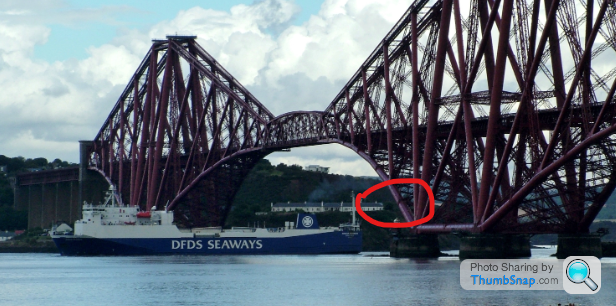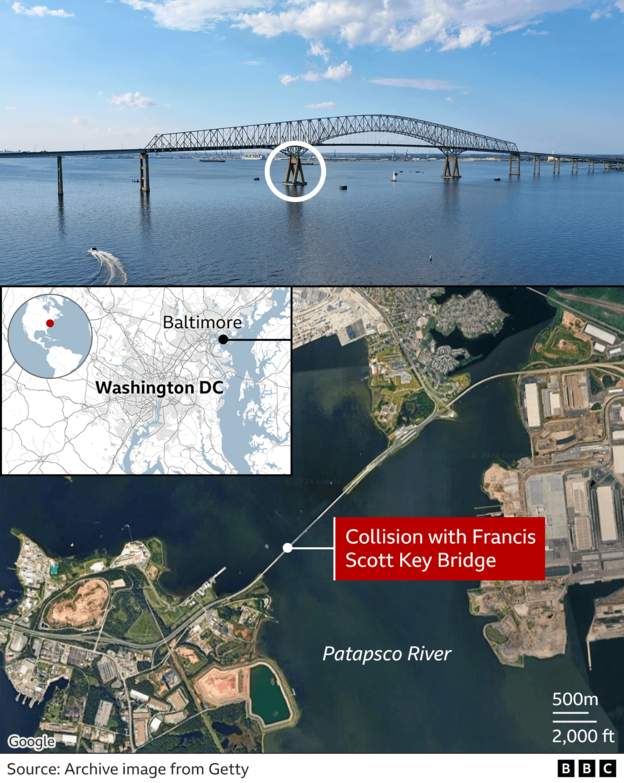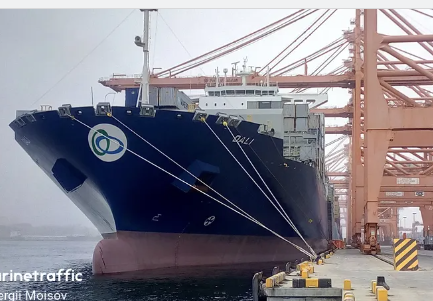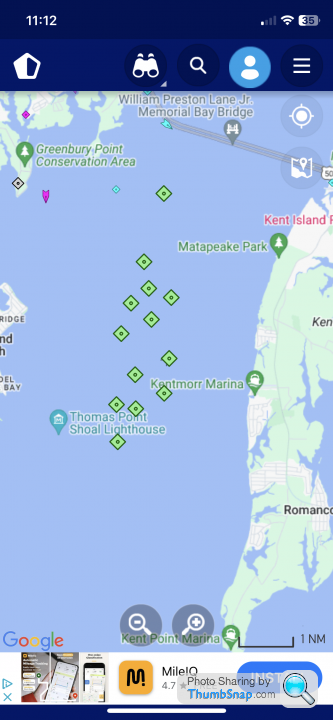Baltimore bridge collapse
Discussion
dxg said:
You forget about the poor state of repair of many US bridges - esp. steel ones.
See the I-35 bridge collapse. Which also had people working on it at the time. But no ship.
There's a long history of a lack of investment in US infrastructure, hence the $1.2tn spending bill passed in Nov to start addressing the issues. Many of the bridges, buildings are at riskSee the I-35 bridge collapse. Which also had people working on it at the time. But no ship.
abzmike said:
Maybe it's the perspective of the video, but that ship looks way too tall to be anywhere near that bridge.
Provided you have 1m clearance below & 1m clearance above you fit. QEII Dartford Crossing for instance requires 1.5m clearance but that requires you pass through the middle of the arch. Some ports are that tight.
Southampton for instance requires 30cm underkeel clearance on a rising tide & 50cm on a falling tide.
People have no idea how tight ports are for big ships. And sadly it is inevitable that sooner or later something will give.
I expect to see mandatory escort towage for bridge transits of large vessels coming soon.
Hammersia said:
Lotobear said:
LimaDelta said:
ro250 said:
Be interested to hear an engineer's view on the collapse as I was surprised to see the whole thing go down, especially the first section to the right.
Enjoy - Poly Bridge GameEdit - not meant to make light of the situation, more to educate those who are unaware how many interlinked structures rely on each other for strength and support. Take away one element and the whole lot comes down.
That footage is truly shocking
The possible weak point / unluckiness in this case is that the deck level on these massive recent cargo ships protuded out far enough to catch the steel upright pillars (rather than the hull hitting the concrete abutment first).
(Example of Forth bridge with small cargo ship to give an idea)


Thankfully it was at 1.30am...and not at 6 or 7.30am....!!
aeropilot said:
Hammersia said:
Lotobear said:
LimaDelta said:
ro250 said:
Be interested to hear an engineer's view on the collapse as I was surprised to see the whole thing go down, especially the first section to the right.
Enjoy - Poly Bridge GameEdit - not meant to make light of the situation, more to educate those who are unaware how many interlinked structures rely on each other for strength and support. Take away one element and the whole lot comes down.
That footage is truly shocking
The possible weak point / unluckiness in this case is that the deck level on these massive recent cargo ships protuded out far enough to catch the steel upright pillars (rather than the hull hitting the concrete abutment first).
(Example of Forth bridge with small cargo ship to give an idea)


Thankfully it was at 1.30am...and not at 6 or 7.30am....!!
As I say, it is the massive overhang at the bow on this sort of ship (the actual ship Dali is shown) that would demolish pretty much any bridge in it's path.

I know that most of the world's economy is moving around on these huge container ships, but at what point is Big too Big? Perhaps it's time these ships were downgraded and more smaller ships should start being built? We had the incident in the Suez Canal where wind was a factor and there have been many other incidents over the years. you only have to look at youtube shipping disaster videos to see the devastation caused!
As for the Vehicles on the bridge, many of us know that if a car goes into water the electrical systems fail and you can't get doors open! Add to that the steel structure of the bridge falling on top of vehicles its going to be a grim task for divers to retrieve bodies.
my thoughts and prayers to the families affected. I'm also wondering what the tide was doing at the time of the incident and which way the estuary current was running, that of course will affect the search for people in the water.
As for the Vehicles on the bridge, many of us know that if a car goes into water the electrical systems fail and you can't get doors open! Add to that the steel structure of the bridge falling on top of vehicles its going to be a grim task for divers to retrieve bodies.
my thoughts and prayers to the families affected. I'm also wondering what the tide was doing at the time of the incident and which way the estuary current was running, that of course will affect the search for people in the water.
fatboy18 said:
As for the Vehicles on the bridge, many of us know that if a car goes into water the electrical systems fail and you can't get doors open! Add to that the steel structure of the bridge falling on top of vehicles its going to be a grim task for divers to retrieve bodies.
my thoughts and prayers to the families affected.
Minor point but all cars have a backup manual handle to exit in case of power failure. I think the big thing is the water pressure on the outside of the doors make it virtually impossible to open them.my thoughts and prayers to the families affected.
fatboy18 said:
I know that most of the world's economy is moving around on these huge container ships, but at what point is Big too Big? Perhaps it's time these ships were downgraded and more smaller ships should start being built? We had the incident in the Suez Canal where wind was a factor and there have been many other incidents over the years. you only have to look at youtube shipping disaster videos to see the devastation caused!
As for the Vehicles on the bridge, many of us know that if a car goes into water the electrical systems fail and you can't get doors open! Add to that the steel structure of the bridge falling on top of vehicles its going to be a grim task for divers to retrieve bodies.
my thoughts and prayers to the families affected. I'm also wondering what the tide was doing at the time of the incident and which way the estuary current was running, that of course will affect the search for people in the water.
There are a few variables in this, but my thoughts on the size of contrainerships echo yours. Only the other week, three dock cranes in Turkey were demolished by an errant container ship.As for the Vehicles on the bridge, many of us know that if a car goes into water the electrical systems fail and you can't get doors open! Add to that the steel structure of the bridge falling on top of vehicles its going to be a grim task for divers to retrieve bodies.
my thoughts and prayers to the families affected. I'm also wondering what the tide was doing at the time of the incident and which way the estuary current was running, that of course will affect the search for people in the water.
See here: https://www.seatrade-maritime.com/ports/yang-ming-...
Also, accounts of the Baltimore incident speak of the lights and power cutting on the vessel, before the crash. So whether the ship suffered a critical failure is unclear. The state of maintenance etc. of these large ship is pretty critical when they are arriving/leaving port. If they have failure at sea, it's general less troublesome. The stopping distance from full speed on these things is in tens of miles.
If it wasn't anything but a tragic accident then someone managed to do an extraordinary amount of damage for little effort. IIRC something like $200m worth of goods are traded through that port every day. That bridge pretty much cuts off the entire harbour, so unless they can find a way through quickly (maybe they can go to one side?) then the trade costs of this will mount up extremely quickly.
Hopefully the casualties are light given the time, goodness knows what would have happened if it had been rush hour.
Hopefully the casualties are light given the time, goodness knows what would have happened if it had been rush hour.
Digga said:
Also, accounts of the Baltimore incident speak of the lights and power cutting on the vessel, before the crash. So whether the ship suffered a critical failure is unclear. The state of maintenance etc. of these large ship is pretty critical when they are arriving/leaving port. If they have failure at sea, it's general less troublesome. The stopping distance from full speed on these things is in tens of miles.
The posted video's clearly show this.....looks like power lost, then regained, then lost again......also there were two port pilots on board, so its unlikely this was a falling asleep at the wheel type event.Singapore flagged vessel, with all Indian crew, being chartered by Maersk.
Hammersia said:
There's really no such thing as redundancy for structures like that, it will be the same result if a ship crashes into the right part of the Forth rail bridge.
The possible weak point / unluckiness in this case is that the deck level on these massive recent cargo ships protuded out far enough to catch the steel upright pillars (rather than the hull hitting the concrete abutment first).
(Example of Forth bridge with small cargo ship to give an idea)

Sitting at home looking out at the Forth Bridge, it’s my view. Some of the big stuff has precious little clearance - the Queen Elizabeth aircraft carrier was under it the other day. But the big stuff also goes under with tugs attached. And a few years ago they added buffers/bumpers/fenders round the supports to the Forth Road Bridge. And it looks like the Queensferry Crossing was built that way. Maybe we have higher safety standards here? You can always tell if there’s something particularly big going to go under the bridge as there’s rugs milling about. The possible weak point / unluckiness in this case is that the deck level on these massive recent cargo ships protuded out far enough to catch the steel upright pillars (rather than the hull hitting the concrete abutment first).
(Example of Forth bridge with small cargo ship to give an idea)

I recall quite a few of the bridges around San Francisco collapsed in an earthquake a few years back. Would ‘our’ bridges have stood up any better? To the untrained eye a lot of the US steel/girder bridges do look fairly fragile.
Dreadful for those working on the Baltimore bridge though…and by a coincidence I was watching something about Baltimore on TV last night.
Edited - just seen the photos of the ship that hit the bridge - it's huge, and loaded! Not a lot would stay standing after that I guess...
Edited by tvrolet on Tuesday 26th March 11:14
fatboy18 said:
I know that most of the world's economy is moving around on these huge container ships, but at what point is Big too Big? Perhaps it's time these ships were downgraded and more smaller ships should start being built?
FWIW, the Dali isn't particularly large as a container vessel - the world's largest come in at roughly 400m by 60m, whereas the Dali is 300m by 47m. How small would you want the limit to be?BBC News said:
What caused this incident is still unclear, but BBC Verify has been looking at video of the collision and the Dali's travel history on ship tracking platform MarineTraffic.
The container ship set off from Baltimore's Seagirt Marine Terminal at around 00:24 local time (04:24 GMT) on 26 March.
Its speed steadily increased and it maintained a straight route south east along the Patapsco River.
Then at 01:25 MarineTraffic data shows that the ship suddenly diverted from its straight course and began to slow down.
Around this time, video shows that all lights on the exterior of the ship suddenly turned off and smoke began emanating from the ship's funnel.
The Dali then hit a portion of the bridge at 01:28, causing it to collapse
Along with having 2 pilots on board it very much suggests a mechanical issue in the engine compartment. The container ship set off from Baltimore's Seagirt Marine Terminal at around 00:24 local time (04:24 GMT) on 26 March.
Its speed steadily increased and it maintained a straight route south east along the Patapsco River.
Then at 01:25 MarineTraffic data shows that the ship suddenly diverted from its straight course and began to slow down.
Around this time, video shows that all lights on the exterior of the ship suddenly turned off and smoke began emanating from the ship's funnel.
The Dali then hit a portion of the bridge at 01:28, causing it to collapse
WestyCarl said:
fatboy18 said:
As for the Vehicles on the bridge, many of us know that if a car goes into water the electrical systems fail and you can't get doors open! Add to that the steel structure of the bridge falling on top of vehicles its going to be a grim task for divers to retrieve bodies.
my thoughts and prayers to the families affected.
Minor point but all cars have a backup manual handle to exit in case of power failure. I think the big thing is the water pressure on the outside of the doors make it virtually impossible to open them.my thoughts and prayers to the families affected.
fatboy18 said:
I know that most of the world's economy is moving around on these huge container ships, but at what point is Big too Big? Perhaps it's time these ships were downgraded and more smaller ships should start being built? We had the incident in the Suez Canal where wind was a factor and there have been many other incidents over the years. you only have to look at youtube shipping disaster videos to see the devastation caused!
The following factors play a significant role in determining size:Whether the ship will use either the Panama or Suez canals
Expected cargo type which determines the port(s) that will be used
Most ships are optimised to a size which is based on what they're carrying and where they're travelling to or from. Going smaller means:
More crews are required which will increase the cost overhead
Busier shipping lanes
Higher risk of bumps
More queues at ports
Potentially more capsizes
As it stands, the current sizes are about right for what we ship around the globe.
Things like the Seawise Giant / Knock Nevis are as big as we could realistically ever go with the materials we currently use. Much bigger and you're looking at having to reinforce substantially and that's before we even consider how a ship like that could perform in a rough sea.
MKnight702 said:
That bridge pretty much cuts off the entire harbour, so unless they can find a way through quickly (maybe they can go to one side?) then the trade costs of this will mount up extremely quickly.
Vessels are already starting to build up - it's likely we'll seen another Suez style buildup in the coming days.
aeropilot said:
Digga said:
Also, accounts of the Baltimore incident speak of the lights and power cutting on the vessel, before the crash. So whether the ship suffered a critical failure is unclear. The state of maintenance etc. of these large ship is pretty critical when they are arriving/leaving port. If they have failure at sea, it's general less troublesome. The stopping distance from full speed on these things is in tens of miles.
The posted video's clearly show this.....looks like power lost, then regained, then lost again......also there were two port pilots on board, so its unlikely this was a falling asleep at the wheel type event.Singapore flagged vessel, with all Indian crew, being chartered by Maersk.
Gassing Station | News, Politics & Economics | Top of Page | What's New | My Stuff


